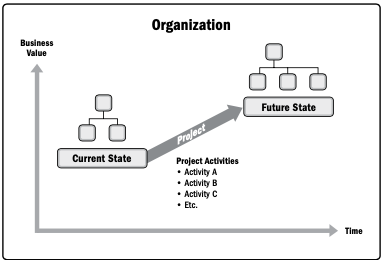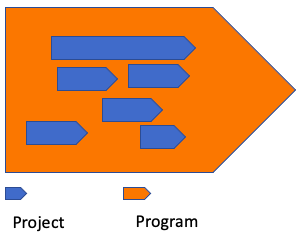Relationship of projects, programs and portfolios
(→Program) |
(→Program) |
||
| Line 38: | Line 38: | ||
[[File: bobobobobo.png |thumb|400px|right| Figure 2: Illustration of a program.]] | [[File: bobobobobo.png |thumb|400px|right| Figure 2: Illustration of a program.]] | ||
So by looking at these three definitions it can be seen a program is a group of projects which have the same strategic goals. It is also worth mentioning that the lifetime of a program can be for several years. It makes sense since the program is a group of projects. A good way to explain it is: If you have a project, and remove one of the activists, the project will most likely be a failure, and thereby not deliver the benefit to the organization. But if you have a program and remove one of the projects, the program can still be beneficial for an organization. The figure, which is shown to the right, is an illustration of a program which has five projects in it. It is seeing the length of the project is different and none of the projects is depending on each other. | So by looking at these three definitions it can be seen a program is a group of projects which have the same strategic goals. It is also worth mentioning that the lifetime of a program can be for several years. It makes sense since the program is a group of projects. A good way to explain it is: If you have a project, and remove one of the activists, the project will most likely be a failure, and thereby not deliver the benefit to the organization. But if you have a program and remove one of the projects, the program can still be beneficial for an organization. The figure, which is shown to the right, is an illustration of a program which has five projects in it. It is seeing the length of the project is different and none of the projects is depending on each other. | ||
| + | |||
When the (ISO 21500:2012) is talking about other activities it is things like controlling the economy of the program. Normally the program will be handed an amount of money, which is then of to manage between the different project. Sometimes a new project will add to the program. This will, of course, mean that the money for each project will be shorted, therefore a program will have the opportunity to ask the organisation for more money. But some times the economy will in the start be calculated with this in mind. There is a number of wiki page on how to manage programs in different ways [[http://wiki.doing-projects.org/index.php/The_Role_of_Program_Management_in_an_Organisational_Change]][[http://wiki.doing-projects.org/index.php/Program_management_in_change_management]]. | When the (ISO 21500:2012) is talking about other activities it is things like controlling the economy of the program. Normally the program will be handed an amount of money, which is then of to manage between the different project. Sometimes a new project will add to the program. This will, of course, mean that the money for each project will be shorted, therefore a program will have the opportunity to ask the organisation for more money. But some times the economy will in the start be calculated with this in mind. There is a number of wiki page on how to manage programs in different ways [[http://wiki.doing-projects.org/index.php/The_Role_of_Program_Management_in_an_Organisational_Change]][[http://wiki.doing-projects.org/index.php/Program_management_in_change_management]]. | ||
| + | |||
| + | === Program Exampel === | ||
== Portfolio == | == Portfolio == | ||
Revision as of 14:30, 16 February 2021
Relationship of projects, programs and portfolios
This wiki page will go into the description and distinctions between Project, Program and Portfolio management. It will start with defining the three different topics, by using standards and recognized books on each of the three topics. Afterwards, the distinctions between the three will be clarified. The topics platforms and lineage will also be mentioned and clarified, due to the comparability between these two and the more well-known types. However, the main focus will be explaining the first three topics and the importance of knowing what kind, a manager is trying to manage. Through the reading on the page, an example will be followed so it will be possible to see a direct and hands-on use of the topics. Through the page reference to PRINCE2, Dansk Standard (DS) and books published by Project Management Institute will be used as background material to verify the statements.
These books will also provide the key element for each of the topics which will be compared to each other to come up with the best and most clear way to navigate through these key differences. The page will also show how they differ by looking at how the topics handle; Scope, change, planning, management, monitoring and success. The outcome from this wiki page will provide a clear and easy understanding of the difference in what a project, program and portfolio are. Also providing a clear view of the difference in the management of these three different types.
Contents |
Project
So for a start, the definitions of a project can be looked upon. There is a lot of different definitions of a project on this page will focus on the acknowledged definitions from DS and PRINCE2.
"... a unique set of processes consisting of coordinated and controlled activities with start and end dates, performed to achieve project objectives. Achievement of the project objectives requires the provision of deliverables conforming to specific requirements.” - (ISO 21500:2012)
"A temporary organization that is created for the purpose of delivering one or more business products according to an agreed business case." - PRINCE2
So be looking at these two definitions it is clear to see the importance of understanding that a project is a temporary organization. This means that when the project has a lifecycle. This lifecycle can both be short and long depending on the project. So it can be said that a project is made to die. This part of a project is explained on the wiki page "The Project Charter" [[1]]. Thereby not said that a project can not have deliverables beyond the end of a project. Which mean that a done project can still have deliverables after the project is done.
When looking at a project from a business perspective, a project is aimed at moving an organization from one state to another state. When looking at it this way the organization is commonly referred to as being in the current state and will move to the future state when the desired result of the change driven by the project is done. In the book "A guide to the project management body of knowledge" By Project Management Institute, they have en following figure which is illustrating it very well. This figure is shown in Figure 1After a project is done one of the things which are used to evaluate the project is, whether the project has been a success or not. This can be done in multiples ways by using different tools. One of the more known tools is "the Iron triandle"[[2]] but it also has its limitations and mentioned in this wiki page "Limitations of the iron triangle" [[3]]. Other tools can be used which can be seen on these wiki pages; [4],[[5]], [[6]].
Project Example
Throughout this wiki page, an example will be used to show what all the theory is talking about. The example will be looking at a car brand. Later on, the car brand will change to clarify understanding. If looking at the theory used in the project part it can be compared to how car brands make new cars. A whole new car is a project for a car brand. When brands start the project they do not necessarily have an end date for the overall project. But they have a start date and an end goal, a brand new car. As the (ISO 21500:2012) mentioned "a unique set of processes consisting of coordinated and controlled activities with start and end dates" here it can be compared to, the designers who need to design a new car and the mechanic who needs to build a new motor. At the end of the project, all of these activities will be combined and the result will hopefully be a new car. So by finishing this project the business values in the organisation will be changed due to a new car will be introduced to the market. Whether the project in itself is a success or not can then be looked at with different tools.
Program
New looking at a program. Once again the definition of a program will be obtained by comparing two well-known writing.
"A programme is generally a group of related projects and other activities aligned with strategic goals." - (ISO 21500:2012)
"A temporary, flexible organization structure created to coordinate, direct and oversee the implementation of a set of related projects and activities in order to deliver outcomes and benefits related to the organization's strategic objectives. A programme is likely to have a life that spans several years." - PRINCE2
".. a group of related projects managed in a coordinated way to obtain benefits and control not available from managing them individually. Programs may include elements of related work outside of the discrete scope of projects in the program." - Project Management Institute
So by looking at these three definitions it can be seen a program is a group of projects which have the same strategic goals. It is also worth mentioning that the lifetime of a program can be for several years. It makes sense since the program is a group of projects. A good way to explain it is: If you have a project, and remove one of the activists, the project will most likely be a failure, and thereby not deliver the benefit to the organization. But if you have a program and remove one of the projects, the program can still be beneficial for an organization. The figure, which is shown to the right, is an illustration of a program which has five projects in it. It is seeing the length of the project is different and none of the projects is depending on each other.
When the (ISO 21500:2012) is talking about other activities it is things like controlling the economy of the program. Normally the program will be handed an amount of money, which is then of to manage between the different project. Sometimes a new project will add to the program. This will, of course, mean that the money for each project will be shorted, therefore a program will have the opportunity to ask the organisation for more money. But some times the economy will in the start be calculated with this in mind. There is a number of wiki page on how to manage programs in different ways [[7]][[8]].
Program Exampel
Portfolio
"A project portfolio is generally a collection of project and programmes and other work that are grouped together to facilitate the effective management of that work to meet strategic" - (ISO 21500:2012)
"The totality of an organization's investment (or segment thereof) in the changes required to achieve its strategic objectives." - PRINCE2

